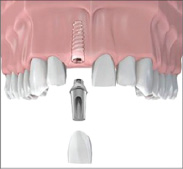Dental implants: Creating myriad health-restoring opportunities
|

Courtesy of Dr. Ken schweifler The above illustration identifies the components of a single-tooth implant crown.
If you’re old enough to remember dental treatment prior to the invention and implementation of dental anesthesia in the 1950s, you will be able to relate to my sentiment that nothing up to that point had such a profoundly positive influence on the field. The ability to block nerve sensation transformed the way we practice, enabling the performance of even the most complex procedures in a pain-free, anxiety-free environment. Perhaps nothing has revolutionized the field of dentistry since as much as dental implants. In the past, when a single tooth was lost, a typical option would be a fixed bridge. Such treatment relies on the teeth adjacent to the missing tooth, often requiring aggressive reduction of healthy teeth that wouldn’t otherwise need to be restored for their own structural benefit. Because fixed bridges are a series of attached crowns, they preclude the ability to use traditional dental floss. Even though there are hygienic options to thread floss underneath the bridge, the technique requires a high level of dexterity and motivation from the patient. In my experience, most patients don’t spend the time to care for them adequately. Over time, the bone that supported the lost tooth (or teeth) dissolves, leaving excessive space between the bridge and the tissue below it and contributing to more plaque/food retention and tissue irritation. Dental implants treat single-tooth problems with single-tooth solutions. An implant designed to replace a single lost tooth has three components: the titanium implant that fuses with the jawbone; the abutment that attaches to the implant and protrudes from the gumline; and the crown (cap) that adheres to the abutment, restoring function and aesthetics. By avoiding the needless restorative treatment on adjacent teeth that a fixed bridge requires, those teeth are preserved with their longevity more likely. Single-tooth implants can be cleaned just like natural teeth, because nothing impedes the passage of conventional floss. When a tooth is lost and restored with an implant, the immediate replacement root (implant) “tricks” the bone, minimizing bone loss. Due to the overwhelming benefits of implants over fixed bridge treatment, to treat a candidate for implants with a fixed bridge would be considered below the standard of care today. Another treatment option, usually selected when more teeth are missing than could be treated well with a fixed bridge, is a removable denture (partial or full). A partial denture uses metal clasps to anchor it to the remaining teeth, and acrylic rests in those areas where teeth are missing and serves as the attachment platform for fake teeth. These clasps are often torquing on teeth already periodontally compromised, leading to the acceleration of tooth loss. Patients with these appliances often complain that they affect speech, impede the sense of taste and create a negative image of old age. Full dentures receive similar complaints, but more pronounced. As multiple teeth are lost, the bony ridge that supported them dissolves. These patients traditionally have relied on the inadequate retention of acrylic against tissue on a shrinking bony ridge. The upper denture benefits from the suction created against the palate. The lower full denture lacks that anatomic advantage and is commonly considered the most annoying, ineffective treatment in dentistry. Complaints about it have been unanimous in my practice – until now. Perhaps the most profound benefits of dental implants are in creating more retention for full dentures, especially on the lower arch. By simply placing two implants on the lower bony ridge and creating a denture that adheres to those implants, the days of uncomfortable, restricted chewing and embarrassing slippage of the appliance in social situations are over. In my experience, reluctance to pursue dental implants has been due primarily to the expense or concerns about failure. Initial treatment for a single-tooth implant is typically more expensive than a fixed bridge or denture, but it’s a much more predictable option that preserves remaining teeth and bone. Studies show that within five to seven years, there’s a failure rate of 30 percent in teeth adjacent to a fixed bridge or removable partial denture. Sure, a three-unit fixed bridge (to replace one missing tooth) may cost less money than an implant, but if it fails because the teeth supporting it succumb to disease, then it’s going to need to be replaced. If I could add up the cost of replacing a fixed bridge or a partial denture, perhaps several times over a lifetime, dental implants are definitely the more economical option. Some of my implant candidates express concerns about the risk of failures. I have heard more about implants failing from conversations my patients have had with friends and loved ones than I have ever seen in my practice. The success rate for dental implants varies from study to study, but generally is more than 90 percent, much higher than any other tooth-replacing option. The impact dental implants have had on the field of dentistry cannot be overstated. We’re fortunate to be living in a time when this technology creates comfortable, health-restoring opportunities. |
Related Blogs
Category : Uncategorized Posted on September 29, 2011





